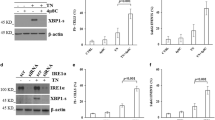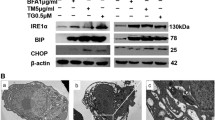ABSTRACT
Purpose
Proteasome inhibition induces endoplasmic reticulum (ER) stress and compensatory autophagy to relieve ER stress. Disturbance of intracellular calcium homeostasis can lead to ER stress and alter the autophagy process. It has been suggested that inhibition of the proteasome disrupts intracellular calcium homeostasis. However, it is unknown if intracellular calcium affects proteasome inhibitor-induced ER stress and autophagy.
Methods
Human colon cancer HCT116 Bax positive and negative cell lines were treated with MG132, a proteasome inhibitor. BAPTA-AM, a cell permeable free calcium chelator, was used to modulate intracellular calcium levels. Autophagy and cell death were determined by fluorescence microscopy and immunoblot analysis.
Results
MG132 increased intracellular calcium levels in HCT116 cells, which was suppressed by BAPTA-AM. MG132 suppressed proteasome activity independent of Bax and intracellular calcium levels in HCT116 cells. BAPTA-AM inhibited MG132-induced cellular vacuolization and ER stress, but not apoptosis. MG132 induced autophagy with normal autophagosome-lysosome fusion. BAPTA-AM seemed not to affect autophagosome-lysosome fusion in MG132-treated cells but further enhanced MG132-induced LC3-II levels and GFP-LC3 puncta formation, which was likely via impaired lysosome function.
Conclusions
Blocking intracellular calcium by BAPTA-AM relieved MG132-induced ER stress, but it was unable to rescue MG132-induced apoptosis, which was likely due to impaired autophagic degradation.






Similar content being viewed by others
Abbreviations
- 2-APB:
-
2-aminoethoxydiphenyl borate
- BAF:
-
Bafilomycin A1
- BAPTA-AM:
-
1,2-bis-(o-aminophenoxy)-ethane-N,N,N′,N′-tetraacetic acid tetraacetoxymethyl esteris
- CPP:
-
calcium phosphate precipitates
- eIF2-alpha:
-
Eukaryotic Translation Initiation Factor 2-alpha
- ER:
-
Endoplasmic Reticulum
- IRE1:
-
Inositol-requiring Enzyme1
- JNK:
-
c-Jun N-terminal Kinase
- LC3:
-
microtubule-associated protein 1 light chain 3
- MEF:
-
mouse embryonic fibroblasts
- PE:
-
Phosphatidylethanolamine
- PERK:
-
Protein Kinase RNA-like Endoplasmic Reticulum Kinase
- PFA:
-
paraformaldehyde
- UPR:
-
Unfolded Protein Response
- UPS:
-
Ubiquitin Proteasome System
- Xec:
-
Xestospongin C
REFERENCES
Hershko A, Ciechanover A. The ubiquitin system. Annu Rev Biochem. 1998;67:425–79.
Mitchell BS. The proteasome—an emerging therapeutic target in cancer. N Engl J Med. 2003;348(26):2597–8.
Adams J. The development of proteasome inhibitors as anticancer drugs. Cancer Cell. 2004;5(5):417–21.
Chauhan D, Hideshima T, Anderson KC. Proteasome inhibition in multiple myeloma: therapeutic implication. Annu Rev Pharmacol Toxicol. 2005;45:465–76.
Ding WX, Ni HM, Yin XM. Absence of Bax switched MG132-induced apoptosis to non-apoptotic cell death that could be suppressed by transcriptional or translational inhibition. Apoptosis: Int J Programmed Cell Death. 2007;12(12):2233–44.
Levine B, Klionsky DJ. Development by self-digestion: molecular mechanisms and biological functions of autophagy. Dev Cell. 2004;6(4):463–77.
Lum JJ, DeBerardinis RJ, Thompson CB. Autophagy in metazoans: cell survival in the land of plenty. Nat Rev Mol Cell Biol. 2005;6(6):439–48.
Kamada Y, Sekito T, Ohsumi Y. Autophagy in yeast: a TOR-mediated response to nutrient starvation. Curr Top Microbiol Immunol. 2004;279:73–84.
Ding WX, Ni HM, Gao W, Yoshimori T, Stolz DB, Ron D, et al. Linking of autophagy to ubiquitin-proteasome system is important for the regulation of endoplasmic reticulum stress and cell viability. Am J Pathol. 2007;171(2):513–24.
Zhu K, Dunner Jr K, McConkey DJ. Proteasome inhibitors activate autophagy as a cytoprotective response in human prostate cancer cells. Oncogene. 2010;29(3):451–62.
Komatsu M, Waguri S, Chiba T, Murata S, Iwata J, Tanida I, et al. Loss of autophagy in the central nervous system causes neurodegeneration in mice. Nature. 2006;441(7095):880–4.
Korolchuk VI, Mansilla A, Menzies FM, Rubinsztein DC. Autophagy inhibition compromises degradation of ubiquitin-proteasome pathway substrates. Mol Cell. 2009;33(4):517–27.
Ding WX, Ni HM, Gao W, Chen X, Kang JH, Stolz DB, et al. Oncogenic transformation confers a selective susceptibility to the combined suppression of the proteasome and autophagy. Mol Cancer Ther. 2009;8(7):2036–45.
Avivar-Valderas A, Salas E, Bobrovnikova-Marjon E, Diehl JA, Nagi C, Debnath J, et al. PERK integrates autophagy and oxidative stress responses to promote survival during extracellular matrix detachment. Mol Cell Biol. 2011;31(17):3616–29.
Amaravadi RK, Lippincott-Schwartz J, Yin XM, Weiss WA, Takebe N, Timmer W, et al. Principles and current strategies for targeting autophagy for cancer treatment. Clin Cancer Res. 2011;17(4):654–66.
Thastrup O, Cullen PJ, Drobak BK, Hanley MR, Dawson AP. Thapsigargin, a tumor promoter, discharges intracellular Ca2+ stores by specific inhibition of the endoplasmic reticulum Ca2(+)-ATPase. Proc Natl Acad Sci U S A. 1990;87(7):2466–70.
Hoyer-Hansen M, Bastholm L, Szyniarowski P, Campanella M, Szabadkai G, Farkas T, et al. Control of macroautophagy by calcium, calmodulin-dependent kinase kinase-beta, and Bcl-2. Mol Cell. 2007;25(2):193–205.
Gao W, Ding WX, Stolz DB, Yin XM. Induction of macroautophagy by exogenously introduced calcium. Autophagy. 2008;4(6):754–61.
Sarkar S, Korolchuk V, Renna M, Winslow A, Rubinsztein DC. Methodological considerations for assessing autophagy modulators: a study with calcium phosphate precipitates. Autophagy. 2009;5(3):307–13.
Williams A, Sarkar S, Cuddon P, Ttofi EK, Saiki S, Siddiqi FH, et al. Novel targets for Huntington’s disease in an mTOR-independent autophagy pathway. Nat Chem Biol. 2008;4(5):295–305.
Itakura E, Kishi-Itakura C, Mizushima N. The hairpin-type tail-anchored SNARE syntaxin 17 targets to autophagosomes for fusion with endosomes/lysosomes. Cell. 2012;151(6):1256–69.
Jager S, Bucci C, Tanida I, Ueno T, Kominami E, Saftig P, et al. Role for Rab7 in maturation of late autophagic vacuoles. J Cell Sci. 2004;117(Pt 20):4837–48.
Rusten TE, Stenmark H. How do ESCRT proteins control autophagy? J Cell Sci. 2009;122(Pt 13):2179–83.
Eskelinen EL, Illert AL, Tanaka Y, Schwarzmann G, Blanz J, Von Figura K, et al. Role of LAMP-2 in lysosome biogenesis and autophagy. Mol Biol Cell. 2002;13(9):3355–68.
Pryor PR, Mullock BM, Bright NA, Gray SR, Luzio JP. The role of intraorganellar Ca(2+) in late endosome-lysosome heterotypic fusion and in the reformation of lysosomes from hybrid organelles. J Cell Biol. 2000;149(5):1053–62.
Ganley IG, Wong PM, Gammoh N, Jiang X. Distinct autophagosomal-lysosomal fusion mechanism revealed by thapsigargin-induced autophagy arrest. Mol Cell. 2011;42(6):731–43.
Li X, Yang D, Li L, Peng C, Chen S, Le W. Proteasome inhibitor lactacystin disturbs the intracellular calcium homeostasis of dopamine neurons in ventral mesencephalic cultures. Neurochem Int. 2007;50(7–8):959–65.
Zhang L, Yu J, Park BH, Kinzler KW, Vogelstein B. Role of BAX in the apoptotic response to anticancer agents. Science. 2000;290(5493):989–92.
Ding WX, Guo F, Ni HM, Bockus A, Manley S, Stolz DB, et al. Parkin and mitofusins reciprocally regulate mitophagy and mitochondrial spheroid formation. J Biol Chem. 2012;287(50):42379–88.
Yamamoto A, Tagawa Y, Yoshimori T, Moriyama Y, Masaki R, Tashiro Y. Bafilomycin A1 prevents maturation of autophagic vacuoles by inhibiting fusion between autophagosomes and lysosomes in rat hepatoma cell line, H-4-II-E cells. Cell Struct Funct. 1998;23(1):33–42.
Mikoshiba K. IP3 receptor/Ca2+ channel: from discovery to new signaling concepts. J Neurochem. 2007;102(5):1426–46.
Peppiatt CM, Collins TJ, Mackenzie L, Conway SJ, Holmes AB, Bootman MD, et al. 2-Aminoethoxydiphenyl borate (2-APB) antagonises inositol 1,4,5-trisphosphate-induced calcium release, inhibits calcium pumps and has a use-dependent and slowly reversible action on store-operated calcium entry channels. Cell Calcium. 2003;34(1):97–108.
Ni HM, Bockus A, Wozniak AL, Jones K, Weinman S, Yin XM, et al. Dissecting the dynamic turnover of GFP-LC3 in the autolysosome. Autophagy. 2011;7(2):188–204.
Klionsky DJ, Abdalla FC, Abeliovich H, Abraham RT, Acevedo-Arozena A, Adeli K, et al. Guidelines for the use and interpretation of assays for monitoring autophagy. Autophagy. 2012;8(4):445–544.
Ni HM, Williams JA, Yang H, Shi YH, Fan J, Ding WX. Targeting autophagy for the treatment of liver diseases. Pharmacol Res. 2012;66(6):463–74.
Rossi D, Barone V, Giacomello E, Cusimano V, Sorrentino V. The sarcoplasmic reticulum: an organized patchwork of specialized domains. Traffic. 2008;9(7):1044–9.
Burdakov D, Petersen OH, Verkhratsky A. Intraluminal calcium as a primary regulator of endoplasmic reticulum function. Cell Calcium. 2005;38(3–4):303–10.
Michalak M, Robert Parker JM, Opas M. Ca2+ signaling and calcium binding chaperones of the endoplasmic reticulum. Cell Calcium. 2002;32(5–6):269–78.
Ding WX, Ni HM, Gao W, Hou YF, Melan MA, Chen X, et al. Differential effects of endoplasmic reticulum stress-induced autophagy on cell survival. J Biol Chem. 2007;282(7):4702–10.
Starkov AA. The molecular identity of the mitochondrial Ca2+ sequestration system. FEBS J. 2010;277(18):3652–63.
Gordon PB, Holen I, Fosse M, Rotnes JS, Seglen PO. Dependence of hepatocytic autophagy on intracellularly sequestered calcium. J Biol Chem. 1993;268(35):26107–12.
Lloyd-Evans E, Platt FM. Lysosomal Ca(2+) homeostasis: role in pathogenesis of lysosomal storage diseases. Cell Calcium. 2011;50(2):200–5.
ACKNOWLEDGMENTS AND DISCLOSURES
Jessica A. Williams and Yifeng Hou contribute equally to this work. The research work in W.X Ding’s lab was supported in part by the NIAAA funds R01 AA020518-01 and National Center for Research Resources (5P20RR021940-07). J. A. Williams was supported by the “Training Program in Environmental Toxicology” [grant 5T32 ES007079] from the National Institute of Environmental Health Sciences. Y.F. Hou was supported by the National Natural Science Foundation of China (# 81072165) and the Shanghai Science and Technology Committee (# 09PJ1402700). The authors are indebted to Dr. Bert Vogelstein (Johns Hopkins University) and Lin Zhang (University of Pittsburgh) for the HCT116 Bax-positive and Bax-negative cell lines.
Author information
Authors and Affiliations
Corresponding author
Electronic supplementary material
Below is the link to the electronic supplementary material.

Supplemental Figure 1
MG132 increased intracellular calcium 2-fold in HCT116 cells and produced similar results in DU145 Cells. (A) HCT116 Bax (-) cells were treated with MG132 (1 μM) for 16 hours. Cells were then stained with 2.5 μM of Fluo-4-AM in calcium-free Hank’s buffer for 30 minutes followed by flow cytometry analysis. Fluorescence intensity (FI) is shown. (B) DU145 Bax (-) cells were treated with MG132 (1 μM) in the presence or absence of BAPTA-AM (10 μM) for 16 hours. Cells were then washed and stained with 2.5 μM of Fluo-4-AM in calcium-free Hank’s buffer for 30 minutes followed by flow cytometry analysis. Representative histogram data are shown. (JPEG 37 kb)

Supplemental Figure 2
BAPTA-AM inhibited MG132-induced cellular vacuolization in DU145 cells. DU145 Bax (-) cells were treated with MG132 (1 μM) in the presence or absence of BAPTA-AM (10 μM) for 12 hours followed by phase-contrast microscopy. Representative images are presented in (A). (B) Vacuolated cells were counted, and results are expressed as percent of vacuolated cells (*p<0.05 vs untreated-control; ^ p<0.05 vs MG132, One Way ANOVA). (JPEG 57 kb)
Supplemental Figure 3
The source of intracellular calcium increase was most likely not ER or extracellular calcium influx. HCT116 Bax (-) cells were treated with MG132 (1 μM) in the presence or absence of Xec (25 nM) or 2-APB (20 μM) for 12 hours followed by phase-contrast microscopy. Representative images are presented in (A). (B) Vacuolated cells were counted, and results are expressed as percent of vacuolated cells. Results are from two individual experiments. (C and D) HCT116 Bax (-) cells were treated with MG132 (1 μM) in the presence or absence of Xec (25 nM) or 2-APB (20 μM) for 16 hours. Cells were then washed and stained with 2.5 μM of Fluo-4-AM in calcium-free Hank’s buffer for 30 minutes followed by flow cytometry analysis. Representative histogram data are shown. (E) HCT116 Bax (-) cells were treated with MG132 (1 μM) in the presence or absence of varying concentrations of EGTA for 12 hours followed by phase-contrast microscopy. Representative images are shown. (PDF 254 kb)

Supplemental Figure 4
MG132 induced ER dilation in DU145 cells. DU145 Bax (-) cells were treated with MG132 (1 μM) for 16 hours, and cells were fixed with 4% PFA before immunostaining for Calnexin (green) for visualization of ER dilation and DAPI (blue) for visualization of the cell nucleus. Representative fluorescence images are shown. (JPEG 30 kb)
Rights and permissions
About this article
Cite this article
Williams, J.A., Hou, Y., Ni, HM. et al. Role of Intracellular Calcium in Proteasome Inhibitor-Induced Endoplasmic Reticulum Stress, Autophagy, and Cell Death. Pharm Res 30, 2279–2289 (2013). https://doi.org/10.1007/s11095-013-1139-8
Received:
Accepted:
Published:
Issue Date:
DOI: https://doi.org/10.1007/s11095-013-1139-8




